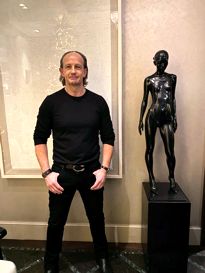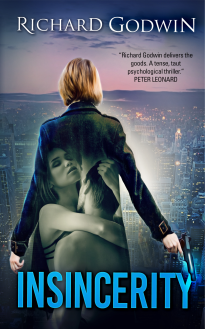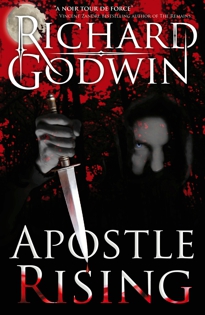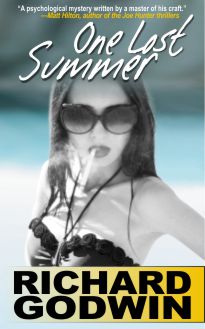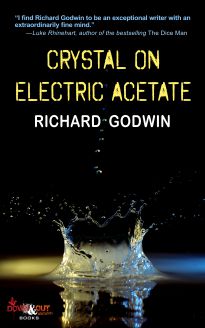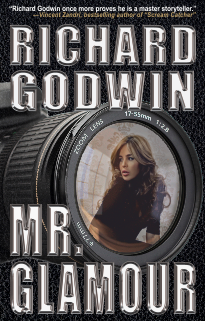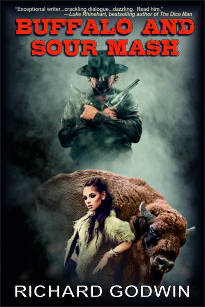
Chris Allinotte lives and works in Toronto. Many of his stories explore themes of isolation and fear of the unknown. His short story, The Dirt on Ronnie Wilkins, won the 2008 Toronto Star National Short Story competition. Chris’ first story to see online publication was called Kittens for Sale, which was published by MicroHorror. He also published 8 Days Of Madness and this year 9 Days Of madness, in which stories by me appeared together with a great list of writers, among them Christopher Grant.
He met me at The Slaughterhouse where we talked about madness and horror.
John Dryden wrote
Great wits are sure to madness near allied
And thin partitions do their bounds divide.
What do you make of his observation?
Ah – madness. I see what you did there. There’s a couple things I take from this:
First, I think the most important part of that quote is “Great”. There are many, many writers who are perfectly adequate. They know how to put together a plot and they do the work necessary to make sure the final copy is clean and professional. However, their work doesn’t really say anything. These writers don’t have anything to worry about, madness-wise. Now, I’d be the first to admit that I’ve written a number of pretty, empty things; but, it’s something that I definitely work at.
It’s the writers who are willing to push into their discomfort zone that are the ones who flirt with “madness”. Think about those books in your collection that call you back again and again. Those are usually the authors who have flirted with the “thin partition”.
Secondly, there’s a place that you can get to when you’re writing when the characters start driving and you feel like you’re being pulled along for the ride. If you think too much about it, it can be scary as hell to look up and find that you’ve been writing for hours. Even more jarring is to realize that you’ve been inhabiting your own world during that time, and it takes you a second to remember where you are. It’s a scary place, in some respects, and it takes something out of you if you spend a lot of your time there. It can make you a bit weird for awhile.
As an example – when I was writing a play back in 2001, I was out with friends one night, decidedly not writing, when the story started playing out in my mind, and I had a physical need to get home and start getting stuff down. I was grabbing napkins and scribbling down dialogue in the palm of my hand while I walked home. It was freaky – I was hearing the character’s voices, and envisioning scenes in places I’d never been. The resulting story is something I’m very proud of, as it managed to get beyond the simple mechanics of plot and ask some hard questions about the world around us.
You’ve got to be willing to scare yourself with your own work if it’s going to say anything worth reading. The flip-side of this is: – who would spend their time putting themselves through hell to tell a fictional story? You’d have to be a little nuts.–
And that’s what I think of Mr. Dryden.
How do you think horror differs from terror?
The short answer is: Horror is when it happens to you; terror is when it happens to me.
I think there’s a very real distinction between the two. In fact, the gap is larger now than it’s ever been, as “horror” seems to have come into vocabulary vogue recently. Lots of things are “horrifying”. It’s become a synonym for “appalling.” The houses on Hoarders are “horrifying”, professional eating contests are “horrifying”. Those pants are … you get it.
Terror, on the other hand, still has some teeth. For me, “terror” describes a state of being pushed beyond regular fear, into a place where you’re gripped with panic, your body is flooding with adrenaline, and your ability to think starts going away.
When you’re faced with something horrifying, you may scream, or you may flee the area. When you’re faced with something terrifying, you may very well shit your pants. That’s a big difference.
When writing “horror” fiction, this distinction is even clearer. There’s plenty of “horror” stories, and many of them are fantastic to read – they may weave in and out of normality and leave the reader feeling satisfied, stunned, and maybe even a little sick at the end. There are a few stories out there, however, that manage to push through “horror” and start to get “terrifying”. These sorts of stories, they end up with the feeling that something is wrong, and it’s wrong in the real world too. The first example that comes to mind is “The Shining.” That book invaded my dreams over and over again. The scenes King wrote with Danny exploring the empty hallways, while the silence and his own fear build to an oppressive level – some of the best “scary” writing I’ve every come across right there.
Personally, I’m also very susceptible to ghost stories. If the writer has “nailed it” with a ghost story – I won’t sleep right for a week after finishing it. That’s a little easier to explain, though. Almost all houses creak at weird random times. If you fill your head full of ghosts and then hear the floorboards crack their knuckles at three o’clock – you’ll jump through the damned ceiling.
So yeah – if you can picture the horror story happening to you – terrifying.
Who are your literary influences?
This is a tough one. I pick up a little something from everythign I read. But there are a handful writers that have had a huge impact on me, so I’ll talk about them.
I’d be an idiot if I didn’t recognize the lasting effect that Stephen King has had on my work. I read Christine when I was young enough to still be giggling at the swear-words, so horror and I have been acquainted for quite awhile. Bar none – my biggest influence is Mr. King.
When I started writing my own stuff, I tended more towards Clive Barker’s earlier style, with fantastic grotesqueries and gobbets of goo and blood flying everywhere. More recently, as I’ve aspired to improve how I write, my scope is a little broader. (I still love Barker though – Imagica is in my top five books of all time.)
I also get a lot of comments that my stories are very visual, like a comic book; and there’s a lot of truth to that. Tom DeFalco’s work on Spider-Man in the 80’s helped form my love of stories. He always managed a wicked balance between scenes of beating up on villains, and dealing with the realities of being a young guy trying to make ends meet, and get laid once in awhile.
Neil Gaiman (another comic-book legend) writes the kind of books that I want to be writing – compact, gorgeous novels where reality is free to weave in and out of true, where little things with teeth live in the shadows, and there’s still sometimes room at the end for a happy ending. I love that.
Alan Moore (more comics), on the other hand, speaks to the cranky, anti-social part of my brain that insists it has something to say about the world. I read Moore’s essay “Writing for Comics” last year, and it completely changed my approach to writing.
Plot, he contends, is the clothing you hang on your idea. If your story doesn’t say anything, it will be, for all intents, a very pretty stuffed shirt. I believe that, and have started building my stories with at least a thin core of observational truth – or opinion at any rate. The tricky part though, which Moore excels at, is to still make the damned thing fun. Nobody wants to be preached at.
Other writers that I can’t get enough of (which is a sure sign I’m drawing literary water from their work) are Philip K Dick, Ray Bradbury, Douglas Adams and Mike Krahulik / Jerry Holkins. The first two play into my obsession with altered realities, and the latter three make me laugh so hard it hurts to breathe. Whenever I’ve managed to blend some humour into a story and it’s worked, it’s largely due to what I’ve learned from these guys.
I’ll leave it there. There’s dozens more authors I admire, and I’m sure they’ve had something to do with how I write today, but I think I’ve covered the big ones.
Is there a particular incident that has changed your life and influenced your writing?
Back in 2000, I was at Theatre School in Toronto, studying Acting. We had a project to do, where we needed to write our own material. I’d always loved English and Creative writing classes, but hadn’t really sat down to create any new stories in about five years.
The theatrical piece I came up with didn’t have a name, but I’ll refer to it as “Jockstrap Wrestling.” In our classes, which were based in the Classical Method, we all had to wear black tights. (Don’t picture it.) All the guys, to a man, hated the “restraint” belt which kept us from looking obscene. I wrote this five minute piece where I flipped out and tore the thing from my body, and proceeded to fight it. Just as I had everyone where I wanted them, the story turned and started demanding answers from the audience to huge questions about how society was raising its children. By the end, no one knew whether to laugh or give me a hug. It was awesome.
That’s the moment, if I think back, that I knew writing was always going to be immensely important to me. There’s been a number of other high points and milestones along the way, and I didn’t really start my current string of penning and publishing until much later -around 2008- but it was “Jockstrap Wrestling” that brought the spark back and got my mind working like a writer.
Do you think the Republican party wear studded jockstraps and if so what does that tell you about them?
I have to say that I’ve never been the least bit interested in American Politics until recently. My attitude is similar to my interest in any sport – I’ll check in during the playoffs and I’ll keep track of who’s winning, but that’s about it. I’m a little better about Canadian politics, as that obviously affects me and my family.
When a vote is coming up, I also dive in and learn as much as I can before I go mark the ballot. Too many people take this right for granted, especially given the staggering amount of lives that have been lost over the years in the name of democracy.
Ok, that’s my chest-thumping statement done…
What the hell is going on in the USA?? The right wing seems to be ripping itself apart. The only way these candidates for the Republicans seem to be able to compete is to claim that they are more extreme in their convictions than the others. There’s no “conservative” in the “Conservatives” anymore.
Studded jock straps? Probably not – as if one candidate was found out to have even seen one, all the others would have attack ads based around the fact by the time the weekend hit. I think there is an absurd amount of hypocrasy around this party. I’m not saying the Democrats are perfect, far from it – but the GOP is basically rallying around the things they will not be letting people do with their lives if they get elected – which makes it all the more glaring when they’re found out to be imperfect themselves.
It’s all the worse, because there are millions of people living in the US who are unhappy with the way things are going in their country, but the only people offering an alternative to the status quo are behaving as if politics were Professional Wrestling. It’s an enormous responsibility, to represent people’s best interests, and they’re turning it into a clown show.
Do you think killing and fucking are related?
Well, they can both be loud and messy, or so quiet that nobody knows it’s even happened until it’s over!
Killing and fucking are similar in basic, primal ways: both are extremes of the human condition, both involve at least two people Both cause an intense physical change in the other person’s state of being.
Sex and killing are also related in the way that love and hate are related. Think of love and hate at opposite ends of a scale. What would be the ultimate expression of each?
Where it gets incredibly confusing (or incredibly interesting, if you’re a writer) is that you can take that same “love/hate” scale, and move sex to any point on that line and get vastly different results. What would a sex scene look like at the “mild loathing” point?
Ooh- now do the same for killing! What happens if you put killing at the extreme end of “love”?
So, yes, I think they’re absolutely related. They are the loudest that anyone can speak to another person without words.
Tell us about your novel.
That, sir, is the million dollar question.
There is a novel. There are several novels. I’ve been trying to get my head around writing one
of them for about two years now.
I did NaNoWriMo in 2009, and finished, but the “novel” I ended up with fell apart in my hands as soon as I touched it in December of that year. It turned out I’d built my house with dried up leaves.
When I set out to write for publication, it was another novel that started me out, a horror novel set around a travelling circus.
Recently, in the last eight months or so, I’ve crystallized around three major stories I want to write. One is a steam-punk/horror hybrid based on a recurring character called “L’homunculus” that I came up with during Lily Childs’ Friday Prediction Challenge. The second is a noir-y thing featuring two other favourite characters of mine, Milton & Blackwood, on the case of a pretty gristly serial killer.
Finally, there’s the book that I’m writing in fits and starts right now. It’s a historical-fantasy-adventure. The problem is not (as I’ve often lamented on my site) that “real life keeps getting in the way”. I mean, there are a few important things that are taking up a lot of my attention, but then, if I was really consumed with writing this book, I’d be using every other spare moment to get into it. And I’m not.
No, the real problem is me – tackling something that big frankly scares the crap out of me. I have a horrible (!) problem shutting my self-editor up as I’m writing, which means it’s often painful to finally get through a short story, so when I’m looking at doing two hundred pages or more, the thought of the process is daunting.
Now – that said, the time has come to either attempt a book, or start to fade quietly into the background. Short stories are great, and I think I will always write them, but I haven’t yet given myself the room to really explore ideas at length, and face the challenge of sustaining action over a long period of time.
So, I’ve set just two goals for myself in 2012. The first is to collect some of my short stories from the past three years into a collection, which is well underway, and looks to be ready for an April launch. The second is to write a novel. Connected to that, and even more important, is to keep going when it gets difficult. (Which I will.)
I’m planning to have a first draft of “Maiden Voyage” done by the summer, and final copy by Christmas. I’ll no doubt be blogging about my progress as it goes. Anyone who catches me whining about it has my full permission to call me on it in the nastiest terms they can manage!
Do you think tomorrow ever comes?
I hope not – that’s when I’ve told everyone my work will be done…
You can make plans for the future. You can schedule things, and they’ll come to pass. If I’m meeting my friends at the pub for beers on Saturday at 8 – there’s nothing really metaphysical going on there; and someone should really plan to call a taxi.
When you talk, however, about tomorrow in the manner of “I’ll be better off in my life tomorrow,” or “I’ll have a first draft done by summer,” then no – that tomorrow doesn’t come. That’s a really common way for people to shelter themselves from having to deal with things today. The problem is that when tomorrow comes, they find out that it’s just another “today.” What that means is that you’ve got to get something done today.
That’s a very black and white way of looking at it, and in some cases, such as when someone is going through a difficult time, all they may have to hold on to is that “tomorrow”, or a day in the near future, they’ll feel a little better. Who am I to say that for them, tomorrow never comes?
So, to straighten all this today/tomorrow stuff out in my head now, let’s just say that time passes, fortunes change and people change, but those things that are only wished for, and not worked at remain forever at the horizon.
Tell us about your project Nine Days Of Madness.
 Nine Days of Madness is the second iteration of a blogfest I started last year during March. I had seen a few of these week-long festivals of stories – in particular Erin Cole’s 13 Days of Horror, which had featured my story Frosted Glass the previous October. I decided that it looked like a lot of fun. (A little selfishly, I also wanted to draw more people to my site.) There’s a really great community of aspiring authors out there, and they seem to gather in various different circles, many of which intertwine. Blog-fests like these tend to be a great time for these folks to get together, have fun, and get some exposure.
Nine Days of Madness is the second iteration of a blogfest I started last year during March. I had seen a few of these week-long festivals of stories – in particular Erin Cole’s 13 Days of Horror, which had featured my story Frosted Glass the previous October. I decided that it looked like a lot of fun. (A little selfishly, I also wanted to draw more people to my site.) There’s a really great community of aspiring authors out there, and they seem to gather in various different circles, many of which intertwine. Blog-fests like these tend to be a great time for these folks to get together, have fun, and get some exposure.
The concept of “Eight Days of Madness”, specifically, started out as a joke. I’m not a sports guy. I’d probably fit in better in some ways if I was, but I’m not – probably never will be. This means that the annual North American basketball craze that is “March Madness” is completely lost on me. I called the blogfest “Madness in March”, and promoted it as an alternative to the NCAA domination of the media. Also, I wanted it to include “The Ides of March” – which then lead to the theme being all about “Madness” itself.
 This is where the idea got a little trickier. I’ve always been intrigued and enthralled by stories where reality is warped, or things are just not as they seem. Some of the classic horror stories and writers did this through characters who were “Mad.” The one thing I didn’t want, was to end up with a collection of stories mocking mental illness. I’ve tried very hard to make a distinction that the kind of “Madness” we’re dealing with in Genre-Horror-World does not really correspond to the modern day DSM-IV classifications. Rather, it was about exploring stories that play with one’s perceptions. Your own story, Richard, managed to generate some of the best debates of the week, as I recall.
This is where the idea got a little trickier. I’ve always been intrigued and enthralled by stories where reality is warped, or things are just not as they seem. Some of the classic horror stories and writers did this through characters who were “Mad.” The one thing I didn’t want, was to end up with a collection of stories mocking mental illness. I’ve tried very hard to make a distinction that the kind of “Madness” we’re dealing with in Genre-Horror-World does not really correspond to the modern day DSM-IV classifications. Rather, it was about exploring stories that play with one’s perceptions. Your own story, Richard, managed to generate some of the best debates of the week, as I recall.
I published seven stories – eight if you include my own, which I tagged on at the end, and I couldn’t have been happier with the diversity of styles and voices I got to display. Sean Patrick Reardon showed up with a father driven to cold blooded murder after the ruin of his only daughter. Benjamin Sobieck gave us the ultimate narcissist, while Laurita Miller brought new meaning to “what’s that noise?”. Each story was phenomenal, and the support of all the people that dropped in to comment made it really great.
When it was over, I wanted it to keep going. The week before the stories went live, I decided to publish the whole thing as a Smashwords E-book. It went better than I could have hoped. To date, there’s been almost 350 downloads of the collection, so this is probably something that will happen again this year. When I published, I changed the name to “Eight Days of Madness” just to remove all, even incidental, similarities to “March Madness.” The NCAA has no reason to pay any attention to me – but putting something in print – you never know.
Nine Days of Madness features (naturally) nine stories this time. (For no other reason that it’s the second year, and it’s one more than last year.)
This time around, there’s a specific theme – “Unsettled”. This was really to make sure that this collection stands out on its own merits; and it produced some excellent variations on the theme. Again- selfishly – these are my favourite kinds of stories to read, so I had the chance to ask for a bunch of them!
Watch for this year’s collection to be made available on Smashwords soon.
Do you think psychiatry is the enemy of Art?
I don’t think so at all.
Sure, it can be argued that some of the greatest works of genius were created by artists who could be seen now as suffering from mental disorders. Would there have been a Sylvia Plath if she’d had access to Xanax?
On the other hand, I think art (and bear with me for a second) is psychiatry for a lot of people. It’s a safe place to dump out the demons. I think of all the dark and disturbing stories, paintings and music out there and wonder for a moment what these people would be like if they weren’t expressing those thoughts in some way, and instead were walking around with those images/words/stories trapped in their skulls. That’s why “art therapy” is a thing.
Not everyone is going to produce brilliance when their mind takes a dump, but I don’t think that should stop anyone from trying. Everyone has something inside them that isn’t all logic and numbers and intellect. It might be something “classic” like an urge to write poetry or prose, painting, music etc. It could just as easily be building scale models or woodworking – anything. Art is anything that expresses something of the person who made it, with the desire that someone, viewing the result, will share that part of the artist – if only briefly.
There’s also people for whom the things inside are just too damned big to possibly get all of it out on paper, canvas, music or whatever. For them, it’s absolutely critical that they get the help they need to achieve the same enjoyment of life as anyone else.
Thank you Chris for an insightful and great interview.

Links:
Author webiste: The Leaky Pencil
Pick up copies of ‘Eight Days of Madness’ and ‘Nine Days of Madness‘ at Smashwords.

 Mystery and crime writer Gary Phillips is a widely published novelist and author of numerous graphic novels. In his brilliant ‘Cowboys’, illustrated by Brian Hurtt, a nightclub shooting changes the lives of two undercover officers. He has a new book out, Scoundrels.
Mystery and crime writer Gary Phillips is a widely published novelist and author of numerous graphic novels. In his brilliant ‘Cowboys’, illustrated by Brian Hurtt, a nightclub shooting changes the lives of two undercover officers. He has a new book out, Scoundrels.







 Undoubtedly de Sade had a huge impact on psychology and literature, as well as on art and film. Obviously the term ‘sadism’ would not have existed without him. But I think it’s the creative genius of the doctors and literati in later years who really took his name and turned the meaning behind it into something significant. I believe it was Krafft-Ebing who first used the word ‘sadism’ (and masochism) in his work, and Freud who married the two to create the term sado-masochism, a ‘pathological’ illness he studied for twenty years. Sexual sadism is, of course, no longer listed in the DSM, and I recently read that the S&M community started referring to themselves as BDSM in an attempt to extricate themselves from the term ‘sadism’ and the horrors it implies – that of arousing pleasure from inflicting pain/torture on a victim, as opposed to consensual role play of dominance and submission.
Undoubtedly de Sade had a huge impact on psychology and literature, as well as on art and film. Obviously the term ‘sadism’ would not have existed without him. But I think it’s the creative genius of the doctors and literati in later years who really took his name and turned the meaning behind it into something significant. I believe it was Krafft-Ebing who first used the word ‘sadism’ (and masochism) in his work, and Freud who married the two to create the term sado-masochism, a ‘pathological’ illness he studied for twenty years. Sexual sadism is, of course, no longer listed in the DSM, and I recently read that the S&M community started referring to themselves as BDSM in an attempt to extricate themselves from the term ‘sadism’ and the horrors it implies – that of arousing pleasure from inflicting pain/torture on a victim, as opposed to consensual role play of dominance and submission. With regards to literature, Sade paved the way for the great writers of erotica (Henry Miller, Anais Nin, Bataille, Catherine Millet et al) but he has also been extensively discussed by philosophers and radical thinkers like Barthes, Sartre, Deleuze and Foucault. And the surrealists have not been quiet about their admiration of the man, with extracts of Justine published in Le Surréalisme au Service de la Revolution and Breton stating, in the first Manifesto of Surrealism, “Sade is surrealist in sadism.” He is also celebrated by artists and film-makers. Man Ray was greatly inspired by him (see images), Bunuel saluted him in his film L’Age D’Or, and Pasolini redressed 120 Days of Sodom in his film Salo. There have, of course, been many many more writers, film-makers and artists who have been inspired by the Marquis in lesser or greater shades of sexual deviancy.
With regards to literature, Sade paved the way for the great writers of erotica (Henry Miller, Anais Nin, Bataille, Catherine Millet et al) but he has also been extensively discussed by philosophers and radical thinkers like Barthes, Sartre, Deleuze and Foucault. And the surrealists have not been quiet about their admiration of the man, with extracts of Justine published in Le Surréalisme au Service de la Revolution and Breton stating, in the first Manifesto of Surrealism, “Sade is surrealist in sadism.” He is also celebrated by artists and film-makers. Man Ray was greatly inspired by him (see images), Bunuel saluted him in his film L’Age D’Or, and Pasolini redressed 120 Days of Sodom in his film Salo. There have, of course, been many many more writers, film-makers and artists who have been inspired by the Marquis in lesser or greater shades of sexual deviancy.
 Links:
Links: